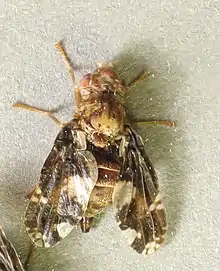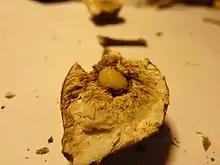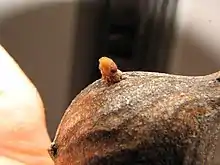| Goldenrod gall fly | |
|---|---|
 | |
| E. solidaginis female | |
 | |
| E. solidaginis puparium | |
| Scientific classification | |
| Domain: | Eukaryota |
| Kingdom: | Animalia |
| Phylum: | Arthropoda |
| Class: | Insecta |
| Order: | Diptera |
| Family: | Tephritidae |
| Subfamily: | Tephritinae |
| Tribe: | Dithrycini |
| Genus: | Eurosta |
| Species: | E. solidaginis |
| Binomial name | |
| Eurosta solidaginis | |
| Synonyms | |
The goldenrod gall fly (Eurosta solidaginis), also known as the goldenrod ball gallmaker, is a species of fly native to North America. The species is best known for the characteristic galls it forms on several species in the Solidago, or goldenrod, genus. The fly's eggs are inserted near the developing buds of the plant. After hatching, the larvae migrate to an area below the plant's developing buds, where they then induce the plant's tissues to form into the hardened, bulbous chamber referred to as a gall. E. solidaginis’s interactions with its host plant(s) and insect, as well as avian, predators have made it the centerpiece of much ecological and evolutionary biology research, and its tolerance of freezing temperatures has inspired studies into the anti-freeze properties of its biochemistry.
Taxonomy
Eurosta solidaginis is in the order Diptera and the family Tephritidae.[6] The Tephritidae are commonly referred to as fruit flies, a common name they share with the Drosophilidae family.[6] The goldenrod gall fly was first put into the genus Eurosta by D. W. Cocquillet in 1910.[7] Two subspecies exist: E. solidaginis subsp. solidaginis and E. solidaginis subsp. fascipennis, distinguished morphologically by differences in hyaline regions of the wing margin.[8] The former subspecies can be further subdivided into two host races, one of which forms galls in Solidago altissima and the other in S. gigantea.[9][10]
Distribution
E. solidaginis is widely distributed across the United States, ranging from Washington all the way to the eastern seaboard.[8][9] The two subspecies occupy different ranges, with E. solidaginis subsp. solidaginis being found from the east coast to Minnesota and the Dakotas, up to the southeastern provinces of Canada, and down the southern border of the United States.[8][9] E. solidaginis subsp. fascipennis, on the other hand, can be found as far west as Washington and as far east as Minnesota.[8]
Behavior and ecology

Adult E. solidaginis emerge from their galls in the spring, with the males emerging prior to the females.[11][12][13] The flies proceed to mate on goldenrod plants, and the females use their ovipositors to insert fertilized eggs into the buds of the goldenrod.[14][9]
Though E. solidaginis has been reported to form galls on seven different species of goldenrod, only three appear to be common targets: Solidago canadensis, S. gigantea and S. altissima.[9] Once the larvae hatch, typically between 5 and 8 days after the egg is laid, the larva eats its way to the base of the goldenrod bud and induces a gall.[9] These galls serve as food sources and shelters from rain, wind and ice.[9] Despite being the larva's overwintering structure, the gall itself does not provide significant insulation.[14][15] Instead, the larva itself has robust freezing tolerance. The larva feeds on the tissues of the gall and molts twice before excavating a narrow exit tunnel out of the gall in mid-September.[9] After digging its tunnel, without actually opening up the gall to the outside, the larva overwinters and, if it survives, molts into an adult and leaves the gall the following spring.[9]
A number of predators and parasites prey on the larvae of E. solidaginis. The black-capped chickadee (Poecile atricapillus) and the downy woodpecker (Picoides pubescens) target large galls, breaking them open and removing the larva living inside.[16][17] The parasitic wasps Eurytoma obtusiventris and E. gigantea also target the gallmaker. The former injects its eggs directly into E. solidaginis larvae prior to gall formation, whereas the latter oviposits into the gall itself.[12] In both cases, the E. solidaginis larvae are consumed. There is also Mordellistena unicolor, a beetle whose larvae, after hatching on the surface of a gall, burrow their way in and feed off of its nutritive tissues.[18] M. unicolor typically kills the E. solidaginis larva inhabiting the gall, but this does not appear to be an essential part of its life cycle.[9] One of the upshots of these interactions is that larvae that produce galls of a moderate size – that is, not small and thin enough for wasps to easily penetrate, but not large enough to attract the attention of birds – have a fitness advantage.[9] In addition to these direct, predatory interactions, a negative correlation has been observed between goldenrod defoliation by Trirhabda beetles, suggesting that competition for plant resources may also have an important role to play in the Eurosta/Solidago system.[19]

Physiology
The ability of E. solidaginis to survive the freezing temperatures of winter has been the subject of much research. In response to dropping temperatures and the senescence of surrounding plant tissues, the larva begins to synthesize and accumulate sorbitol and glycerol in its tissues.[20][21][22] These compounds help protect the larvae against freezing damage by lowering the melting point of their bodily fluids, thus reducing the amount of ice that can form.[23] Aquaporins, membrane proteins involved in the channeling of water, have also been shown to play a key role in E. solidaginis’ freezing tolerance.[24][25] As ice forms in the larva's bodily fluids, solutes in the unfrozen liquid are concentrated, creating a strong osmotic gradient. In species like E. solidaginis that can channel water quickly enough in response to this freezing stress, water rapidly travels to the solute-rich extracellular environment, switching places with cryoprotectant molecules like glycerol, thus protecting the larva's tissues.[25][26] Upregulation of these aquaporin proteins in the winter seasons corroborates the hypothesis that they play a key role in freezing tolerance.[24] It has also been found that mild winter temperatures are detrimental to the survival rate of E. solidaginis, with researchers speculating that cool or freezing temperatures may actually benefit the insect by allowing it to conserve energy[27]
References
- 1 2 Fitch, A. (1855). "Report on the noxious, beneficial and other insects of the State of New York. [I]". Transactions of the New-York State Agricultural Society. (1854) 14: 705–880.
- ↑ Harris, T.W. (1835). Insects. Pp. 553-602. In Hitchcock, E., Report on the geology, mineralogy, botany, and zoology of Massachusetts. 2nd Edition. Amherst: J. S. & C. Adams. pp. [4] + 702 pp., 19 pls, 3 maps.
- ↑ Harris, T.W. (1841). A report on insects of Massachusetts, injurious to vegetation. [1st edition]. Cambridge: Folsom, Wells & Thurston. pp. viii + 459.
- ↑ Johnson, C.W. (1930). "A list of the insect fauna of Nantucket, Massachusetts". Publ. Nantucket Maria Mitchell Assoc. 3 (2): 1–174.
- ↑ Strickland, E.H. (1938). "An annotated list of the Diptera (flies) of Alberta". Canadian Journal of Research. 16 (7): 175–219. doi:10.1139/cjr38d-012.
- 1 2 Borror, D. J.; White, R. E. (1970). Insects. Boston: Houghton Mifflin Company.
- ↑ Cocquillet, Daniel W. (1910). "The type species of the North American genera of Diptera" (PDF). Proceedings of the United States National Museum. Government Printing Office. 37: 534.
- 1 2 3 4 Ming, Y. (1989). A revision of the genus Eurosta Loew with a scanning microscopic study of taxonomic characters (Diptera: Tephritidae) (Master's thesis). Pullman, WA: Washington State University.
- 1 2 3 4 5 6 7 8 9 10 11 Abrahamson, Warren G.; Weis, Arthur E. (1997). Evolutionary ecology across three trophic levels: goldenrods, gallmakers, and natural enemies. New Jersey: Princeton University Press. ISBN 9780691012087.
- ↑ Waring, Gwendolyn L.; Abrahamson, Warren G.; Howard, Daniel J. (1990). "Genetic differentiation among host-associated populations of the gallmaker Eurosta solidaginis (Diptera: Tephritidae)". Evolution. 44 (6): 1648–1655. doi:10.1111/j.1558-5646.1990.tb03853.x. PMID 28564317.
- ↑ Anderson, R. M.; McCrea, K. D.; Abrahamson, W. G.; L. M., Hartzel (1989). "Host genotype choice by the ball gallmaker Eurosta solidaginis (Diptera: Tephritidae)". Ecology. 70 (4): 1048–1054. doi:10.2307/1941373. JSTOR 1941373.
- 1 2 Weis, A. E.; Abrahamson, W. G. (1985). "Potential selective pressures by parasitoids on the evolution of a plant-herbivore interaction". Ecology. 66: 1261–1269. doi:10.2307/1939179. JSTOR 1939179.
- ↑ Craig, T. P.; Itami, J. K.; Abrahamson, W. G.; Horner, J. D. (1993). "Behavioral evidence for host-race formation in Eurosta solidaginis". Evolution. 47 (6): 1696–1710. doi:10.1111/j.1558-5646.1993.tb01262.x. PMID 28567992.
- 1 2 Uhler, Lowell D. (1951). Biology and ecology of the goldenrod gall fly: Eurosta solidaginis (Fitch). Vol. 300. Cornell University Agricultural Station Memoir. pp. 1–51.
- ↑ Layne, Jack R. (1993). "Winter microclimate of goldenrod spherical galls and its effects on the gall inhabitant Eurosta solidaginis (Diptera: Tephritidae". Journal of Thermal Biology. 18 (3): 125–130. doi:10.1016/0306-4565(93)90025-O.
- ↑ Schlichter, Lyanne (1978). "Winter predation by black capped chickadees and downy woodpeckers on inhabitants of the goldenrod ball gall". Canadian Field-Naturalist. 92: 71–74.
- ↑ Abrahamson, Warren G.; Sattler, Joan F.; McCrea, Kenneth D.; Weis, Arthur E. (April 1989). "Variation in selection pressures on the goldenrod gall fly and the competitive interactions of its natural enemies". Oecologia. 79 (1): 15–22. Bibcode:1989Oecol..79...15A. doi:10.1007/BF00378234. ISSN 0029-8549. PMID 28312807. S2CID 206777734.
- ↑ Ping, Chi (1915). "Some inhabitants of the round gall of goldenrod". Journal of Entomology and Zoology: 161–179.
- ↑ Cunan, Ellery T.; Powell, Thomas H. Q.; Weis, Arthur E. (April 2015). "Evidence For Plant-mediated Competition Between Defoliating and Gall-forming Specialists Attacking Solidago altissima". The American Midland Naturalist. 173 (2): 208–217. doi:10.1674/amid-173-02-208-217.1. ISSN 0003-0031. S2CID 86758210.
- ↑ Baust, John G.; Lee, Richard E. (January 1982). "Environmental triggers to cryoprotectant modulation in separate populations of the gall fly, Eurosta solidaginis (Fitch)" (PDF). Journal of Insect Physiology. 28 (5): 431–436. doi:10.1016/0022-1910(82)90070-1.
- ↑ Rojas, Robert R.; Lee, Richard E.; Baust, John G. (December 1986). "Relationship of environmental water content to glycerol accumulation in the freezing tolerant larvae of Eurosta solidaginis (Fitch)". Cryobiology. 23 (6): 564. doi:10.1016/0011-2240(86)90117-3.
- ↑ Irwin, J.T.; Bennett, V.A.; Lee Jr, R.E. (26 March 2001). "Diapause development in frozen larvae of the goldenrod gall fly, Eurosta solidaginis fitch (diptera: tephritidae)" (PDF). Journal of Comparative Physiology B. 171 (3): 181–188. doi:10.1007/s003600000154. ISSN 0174-1578. PMID 11352100. S2CID 3056255.
- ↑ Muldrew, Ken; Acker, Jason P.; Elliott, Janet A. W.; McGann, Locksley E. (2004). "The water to ice transition: implications for living cells". In Fuller, Barry J.; Lane, Nick; Benson, Erica E. (eds.). Life in the Frozen State. pp. 67–108. doi:10.1201/9780203647073. ISBN 9780203647073.
- 1 2 Philip, Benjamin N.; Lee, Richard E. (July 2010). "Changes in abundance of aquaporin-like proteins occurs concomitantly with seasonal acquisition of freeze tolerance in the goldenrod gall fly, Eurosta solidaginis" (PDF). Journal of Insect Physiology. 56 (7): 679–685. doi:10.1016/j.jinsphys.2009.12.003. PMID 20005232.
- 1 2 Philip, B. N.; Yi, S.-X.; Elnitsky, M. A.; Lee, R. E. (2008). "Aquaporins play a role in desiccation and freeze tolerance in larvae of the goldenrod gall fly, Eurosta solidaginis". Journal of Experimental Biology. 211 (7): 1114–1119. doi:10.1242/jeb.016758. ISSN 0022-0949. PMID 18344486.
- ↑ Lee, Richard E. (1989). "Insect cold-hardiness: to freeze or not to freeze" (PDF). BioScience. 39 (5): 308–313. doi:10.2307/1311113. JSTOR 1311113.
- ↑ Irwin, Jason T; Lee, Richard E (May 2000). "Mild winter temperatures reduce survival and potential fecundity of the goldenrod gall fly, Eurosta solidaginis (Diptera: Tephritidae)" (PDF). Journal of Insect Physiology. 46 (5): 655–661. doi:10.1016/S0022-1910(99)00153-5. PMID 10742513.